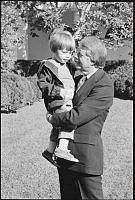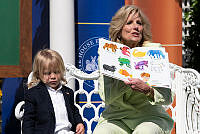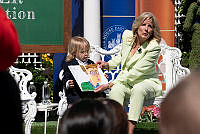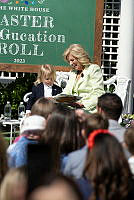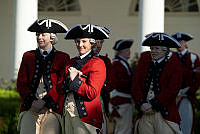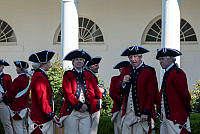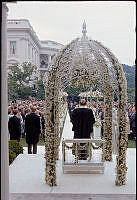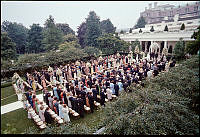Rubenstein Center Scholarship
Benjamin Banneker
The Black Tobacco Farmer who the Presidents Couldn't Ignore
This article is part of the Slavery in the President’s Neighborhood initiative. Explore the Timeline
Benjamin Banneker, a free African-American man living in a slave state in the eighteenth century, never knew the weight of iron shackles or the crack of an overseer’s whip. A native of Baltimore County, Maryland, his experience diverged from those of most African Americans living in the early United States. He received a formal education during his youth, maintained his property and farm as an adult, and parlayed his intellectual gifts into national prestige. Despite his many accomplishments, however, Banneker was forced to navigate the same racial prejudices that African Americans often faced in both slave and free states.
In many ways, his story is an historical anomaly. He assisted with the initial survey of Washington, D.C., published abolitionist material south of the Mason-Dixon Line, and engaged with some of the country’s founders in a way no black man had before. However, Banneker’s life also reflects the defining paradox of the early United States—a land of freedom and opportunity with insurmountable racial qualifiers—which the nation’s capital would come to embody.
Born on November 9, 1731, Banneker grew up on a 100-acre tobacco farm owned by his parents – a formerly enslaved man and the daughter of a mixed-race couple – along the Patapsco River in the area now known as Oella.1 As African-American homesteaders, the family experienced not just freedom but also a quintessentially American vision of independence and economic self-determination that was rarely possible for nonwhites. Still, the color of their skin alienated them from the community of nearby farmers. Amid a rising tide of sentiment against free blacks in the colonies, Banneker’s family had to tread lightly in their own neighborhood.2

Plan of the city of Washington in the territory of Columbia: ceded by the states of Virginia and Maryland to the United States of America, and by them established as the seat of their government, after the year 1800. Banneker worked as an assistant surveyor with Andrew Ellicott, mapping the lands and creating the boundaries for the new federal capital.
Library of CongressNevertheless, Benjamin received an education that was uncommon not just for his race, but for his geographic location, where literacy was relatively low. His grandmother, an Irish-born former indentured servant, taught him how to read and write, and Benjamin continued his studies alongside both white and black classmates at a one-room school nearby.3 His hunger for knowledge went beyond the classroom. In his early twenties, Banneker gained local admiration by hand-carving a wooden clock that kept perfect time—he had studied the gears of a pocket watch to master the mechanics.4 There would not have been many clocks in rural Maryland in the mid-eighteenth century, and Banneker’s was later referred to as “one of the curiosities of the wild region.”5
Though Banneker hosted many visitors who came to see the clock, it took him years to find an intellectual community. In 1771, the Ellicotts, a Quaker family from Pennsylvania, moved to Baltimore County and established a gristmill just a few miles down the road from Banneker’s tobacco farm.6 Perhaps owing to his reputation as a man of letters, or due to his curiosity about construction of the mill, Banneker soon connected with his new neighbors—in particular George Ellicott, a land surveyor with a passion for astronomy who loaned Banneker technical books and lunar tables. Banneker had already sold off some of his land to finance his retirement, and since he was spending less time on the farm, he quickly mastered the discipline.7 In 1789, the year he turned fifty-eight, he forecast his first eclipse.8
Meanwhile, the stars were aligning for Banneker on Earth. On July 16, 1790, Congress passed the Residence Act, establishing a new Federal City to be constructed along the Potomac River.9 President George Washington appointed three commissioners to oversee its construction and Andrew Ellicott, George’s cousin, was brought on as practical engineer.10 Needing assistance on the project and with his usual associates otherwise occupied, Andrew invited Banneker to join him in mapping out the future seat of the federal government. It was the first time in his life Banneker ventured more than ten miles from his farm.11 Click here to learn more about the enslaved households of President George Washington.
“[Ellicott] is attended by Benjamin Banniker, an Ethiopian, whose abilities, as a surveyor, and an astronomer, clearly prove that Mr. Jefferson’s concluding that race of men were void of mental endowments, was without foundation.”
Letters from Ellicott show that in February 1791, he set out with Banneker and several field laborers for Jones Point, Virginia, to plot the boundary lines of the nascent Federal City.12 Because of his age, health, and the harsh winter climate, Banneker’s primary responsibilities were in the observatory tent, where he maintained the regulator clock using a series of thermometers and a transit and altitude instrument. Each day, Ellicott would use the regulator clock to set his own timepiece, which he would use to determine latitude. At night, Banneker would record astronomical observations.13 He was paid $2 a day for his work—less than Ellicott’s $5 but commensurate with salary for assistant surveyors at that time.14
President Washington and Secretary of State Thomas Jefferson – whose 1785 book Notes on the State of Virginia stated that people of African descent were intellectually inferior to whites – were aware of Banneker’s participation. Meanwhile, an article about the survey in the Georgetown Weekly Ledger praised Banneker’s abilities: “[Ellicott] is attended by Benjamin Banniker, an Ethiopian, whose abilities, as a surveyor, and an astronomer, clearly prove that Mr. Jefferson’s concluding that race of men were void of mental endowments, was without foundation.”15 On April 15, 1791, the commissioners, Ellicott, and spectators took part in a ceremony at Jones Point to install the first of the four stone markers that would mark the corners of the Federal District. While Banneker is not mentioned in any of the reports from that day, he undoubtedly would have attended.16 Click here to learn more about the enslaved households of President Thomas Jefferson.
In April of 1792, about a year after Banneker returned to his farm, Washington’s appointed commissioners initiated the practice of renting enslaved laborers from their owners for capital building projects, mostly to cut labor costs.17 The work of enslaved people thus undergirded construction of the capital whose territory Banneker had helped survey, from the clearing and paving of roads to the quarrying and transporting of stone to the building of the White House and Capitol Building.18
After consulting on the Federal City project, Banneker returned to his farm in April 1791 and resumed work on an almanac for farmers.19 At the time, almanacs were mainly used to predict long-range weather patterns, but they also provided a way to share opinions and other types of content. As many of his possessions were destroyed in a fire shortly after his death, Banneker’s slim booklets, published annually from 1792 to 1797 by white northern abolitionists, offer a rare window not only into the author’s skill as an astronomer, but also into his personality and outlook.20 They reveal a man with a full heart and an active mind, at turns contemplative and light-hearted — a scientist on one page and a philosopher on the next.
Banneker’s publishing debut, Benjamin Banneker's Pennsylvania, Delaware, Maryland and Virginia Almanack and Ephemeris, for the Year of Our Lord 1792, makes no reservations about the author’s race. It begins with testimonials from the editors and from James McHenry, a prominent Maryland statesman, attesting to the author’s gifts. “I consider this Negro as fresh proof that the powers of the mind are disconnected with the colour of the skin,” McHenry writes.

Benjamin Banneker's Pennsylvania, Delaware, Maryland and Virginia Almanack and Ephemeris, for the Year of Our Lord 1792
Library of CongressThe following pages contained an essay on the cosmos, a fable about domestic life, a formula for tree medicine, and words of wisdom. Finally, the almanac takes up advocacy, publishing an excerpt from an essay by abolitionist David Rittenhouse originally printed in Columbian Magazine.21 With few publishers capable of checking Banneker’s calculations, the task of peer review had fallen to Rittenhouse, a scientist and fellow surveyor who called the almanac’s measurements “a very extraordinary performance, considering the colour of the Author.”22 Though Rittenhouse was approving his work, Banneker nevertheless took umbrage at this qualification, writing, “I am annoyed to find that the subject of my race is so much stressed. The work is either correct or it is not. In this case, I believe it to be perfect.”23
Banneker was clearly frustrated by the attention paid to his race instead of his work. No matter how unique his talents or special his accomplishments, contemporaries and critics always reverted to a discussion of his skin color. There was no talking about Benjamin Banneker—even in praise—without remarking on his background. He could never truly know whether his almanac was worthy of publication on its own merits or just because it served a moral cause. Though he was never enslaved, Benjamin Banneker was never free to be just Benjamin Banneker. He was always “Benjamin Banneker, a free black” or “Benjamin Banneker, a sable descendant of Africa.”24
Perhaps it was exhaustion as much as outrage that led Banneker to mail an advance copy of the almanac to Secretary of State Jefferson on August 19, 1791. Because the almanac was still in production, Banneker handwrote the entire forty-eight-page publication again.25 Accompanying the almanac was a 1,400-word letter challenging the secretary of state.
Invoking Jefferson’s comparison of British rule of the colonies to an intolerable “State of Servitude,” Banneker pointed out the hypocrisy of Americans who were forcing blacks – “my brethren,” he calls them – into actual servitude:
How pitiable is it to reflect, that altho you were so fully convinced of the benevolence of the Father of mankind, and of his equal and impartial distribution of those rights and privileges which he had conferred upon them…that you should at the Same time be found guilty of that most criminal act, which you professedly detested in others, with respect to yourselves.
He stopped short of telling Jefferson to emancipate the men, women, and children he enslaved – Jefferson owned over 600 during his lifetime – but the message was clear. Banneker used his almanac as an extension of himself, a man “of the African race...of the darkest dye,” to prove that black people were as capable as whites, and would show it if they were given their freedom.26
Jefferson passively entertained Banneker’s suggestions in a reply on August 30. He wrote: "[N]o body wishes more ardently to see a good system commenced for raising the condition both of their body and mind to what it ought to be, as fast as the imbecillity of their present existence, and other circumstances which cannot be neglected, will admit."27
Rather than commit to any political action, Jefferson let Banneker know that he had forwarded the almanac to Marquis de Condorcet, a French philosopher and mathematician, calling it “a document to which your whole colour had a right for their justification against the doubts which have been entertained of them.”28 Of course, Jefferson himself had been casting these doubts, and a letter he wrote to his friend Joel Barlow in 1809 revealed the almanac had hardly affected him. “I have a long letter from Banneker,” Jefferson wrote, “which shews him to have had a mind of very common stature indeed.”29

Dated August 30, 1791, Secretary of State Thomas Jefferson penned this letter in response to Benjamin Banneker questioning his commitment to liberty. Jefferson—a slave owner—acknowledged the paradox and expressed his personal distaste for the institution, but did little else to directly address the issue.
Thomas Jefferson Papers, Library of CongressNot to be deterred, Banneker published his correspondence with Jefferson shortly after the appearance of the almanac for 1792.30 The pamphlet circulated quickly, going through two editions in 1792, and several other magazines and almanacs reprinted the exchange during the 1790s, including the Baltimore edition of Banneker’s 1793 almanac. The letters reinvigorated discourse over the problem of slavery. But Banneker did not advocate for abolition in his almanacs thereafter – possibly because it was dangerous to push the envelope further in a state that permitted slavery. Instead, from 1794 onward Banneker’s claims about the dignity and intelligence of African Americans came primarily through the medium itself – an annual almanac that was as good as any, with an image of the author on the cover.31
On October 9, 1806, Banneker died at his farm in Oella. Days later, during his funeral, his house caught fire, destroying most of his writings and possessions.32 He never married and had no children. Therefore, much of what we know about him today comes from records left behind by others. Martha Ellicott Tyson, George Ellicott’s daughter, wrote biographies of Banneker in 1854 and 1884, and in 1845, John H. B. Latrobe, shared stories about Banneker he had collected from his acquaintances for the Maryland Historical Society.33 Like many before him, Latrobe delivered those memories and recollections to make a point about equality.34

Benjamin Bannaker's Pennsylvania, Delaware, Maryland, and Virginia Almanac, for the Year of Our Lord 1795
Courtesy of the Maryland Historical SocietyPerhaps owing to the scarcity of recorded fact about his remarkable life, and because he was often invoked symbolically to advance social causes like abolition, Banneker’s story has been susceptible to mythmaking. He has been incorrectly credited with drawing the street grid of Washington, D.C., making the first clock on the Eastern seaboard, being the first professional astronomer in America, and discovering the seventeen-year birth cycle of cicadas. With little documentation regarding enslaved people and the lives they lived, and only slightly more about free African Americans in early Washington, Banneker stands out for a number of reasons, not the least of which are his encounters with the nation’s most well-known historical figures. Inevitably, Banneker— the man and the myth—has come to represent the talents and personalities of millions of other African Americans whose lives history failed to preserve.
A free, black, self-made man surveying the future capital would seem to align with the American ideals of individualism and equal opportunity. But the epic construction projects for which Banneker helped plant the first stake were carried out heavily on the backs of enslaved laborers – people of common descent who were explicitly denied those ideals. In this sense, Banneker lived at the center of conflicting stories about the founding of the United States, a contradiction that Washington, D.C. epitomized. Moreover, his interactions with whites – from abolitionists like Rittenhouse to a slave owner like Jefferson – show that even free blacks never escaped the confines of race. While he has rightfully been held up as an example of African-American excellence, Banneker’s presence at this ideological crossroads, and his persistence through it, also make his story definitively American – with no qualifiers warranted.


